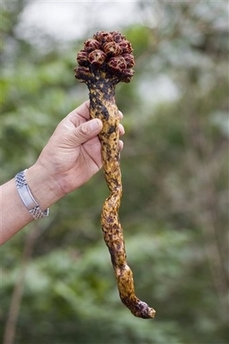Rare parasitic plant found
(Agencies)
Updated: 2008-05-01 19:22
Updated: 2008-05-01 19:22
ST. LOUIS - A scientist with the Missouri Botanical Garden has rediscovered and identified a rare parasitic plant that hasn't been seen by botanists in more than 20 years.
 In this photo provided by Missouri Botanical Garden, a man holds up a portion of the stem and flowers of a newly rediscovered parasitic plant in its natural habitat Monday, June 12, 2006, in Guerrero, Mexico. The a rare parasitic plant hasn't been seen by botanists in more than 20 years. [Agencies] |
A single specimen of the plant was found in Mexico in 1985, but the plant wasn't seen again until St. Louis botanist George Yatskievych and a colleague found it in a pine oak forest in Mexico's mountains.
The plant, which he is identifying and naming for the first time, is not a classic beauty. The odd, orange-brown, fleshy-stemmed plant - which will have the formal Latin name for the "little hermit of Mexico" - has a pine cone-shaped dense cluster of flowers and juicy celery-like stalks.
But to Yatskievych, it's "weird and wonderful."
"I've always been interested in plants that don't conform to our preconceived notion of what a plant should be," he said. "Beauty is in the beholder's eye and this plant is wonderful in so many ways.
"You can't call it ugly, but on the other hand, I recognize it's not everyone's cup of tea."
Wayt Thomas, scientist at the New York Botanical Garden, was looking for other plants in Mexico when he encountered a single specimen of the plant in 1985.
He cut a piece of it, and kept a dried, pressed specimen at his institution. He sent queries and photos of it to fellow botanists, but no one recognized or claimed it, he said, not even the late Larry Heckard who was the leading North American expert on parasitic plants. It went unrecognized because parasitic plants, when dried, don't maintain their color and structure well.
"It sat around for a long, long time," Thomas said.
But by luck, he met an Austrian botanist who referred him to Yatskievych, who is writing text for the encyclopedic "Flora of North America," on the very family of flowers he believed the Mexican plant was in. Plants in the family Orobanchaceae attach as parasites on the roots of host plants.
Photosynthesis, the process by which plants use sunlight and water to create energy in the form of sugar, is hard work, Yatskievych said, and these parasitic plants have developed a way to "steal their food" and hence survive in habitats that otherwise might be inhospitable.
When Yatskievych received Thomas' specimen in 2005, his response was, "What the heck is this?" He traveled to Guerrero, Mexico, the following year to meet with the same guide who helped Thomas two decades earlier.
|
||
|
||
|
|
|
|

